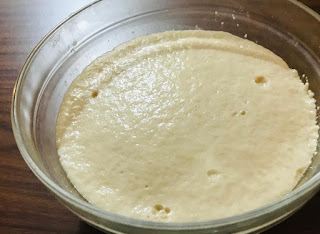I started baking bread more than
15 years back.
We like bread, but we prefer whole wheat bread to that made using maida/refined flour,
It is very difficult to find whole
wheat bread in the market. Even the ones we get with the label `Wheat bread’ are
also a mix of maida and wheat flour, I guess. Because if it is only wheat bread, it feels
heavy to handle whereas the only maida or wheat-maida mix bread is lighter. A local
baker even told me that one has to add 50% maida or else the bread will
not rise!
Once I came across a recipe for
whole wheat bread in a news paper. And
that was the take off point for my bread making! I tried it and on repeated trials, succeeded in getting a perfect loaf of bread! And it does rise without adding
maida!
If you go through the recipe, you
may feel that it a difficult task. But it is not so. It is time consuming that
is all. In the sense, you will have to wait for at least two to three hours for the flour
to rise and nearly about half an hour for baking. Including the preparation time, the process takes about four to five hours.
Here is the recipe.
Ingredients:
Whole wheat flour 4
cups
Dry yeast 1 teaspoon
Jaggery powder/honey 2 teaspoons
Salt 1 teaspoon
Warm water About 1 ½ cups
Sesame seeds (optional) 2 teaspoons
Procedure:
Add salt to flour, mix well.
Dissolve jaggery in about ¼ cup of
water. Heat this to a lukewarm temperature.
If you take honey, add lukewarm water to it and stir well.
Add dry yeast granules to this and
mix well. Allow it to rise. It takes
about 15-20 minutes to rise.
Next add this to the flour and mix well.
Now add required amount of warm
water and mix well. Let the consistency be a bit softer than the flour you mix
for making chapathis. Now you have to knead this very well. The more you knead,
the more it rises. I knead it for about ten minutes.
After kneading, cover it with a
warm cloth, keep it in a warm place and allow it to rise. If the room
temperature is not warm, I keep this in the oven and turn the oven on to about
20 degrees Celsius and leave it for 2 to 3 hours. The flour should rise to
nearly three times that of the original size.
Baking:
Keep a greased baking trey ready.
Now knead the flour again for one
or two minutes. Better dip your hand in water once before you start kneading since the flour might stick to your hand and make it difficult to knead. Now roll the flour with hand to fit into the trey and then transfer this
to the trey.
Now again cover with warm cloth and allow it to rise in the trey for about
half an hour.
Next sprinkle sesame seeds uniformly on the flour. These seeds give a good taste to the bread when they get roasted during baking.
Preheat the oven to 200 degrees
Celsius for five minutes. Bake for about 25 minutes at this temperature.
To check if the bread is done, insert a knife in the middle of the loaf. If it comes out clean it means that it is done. To check further, take out the trey and knock on the bread lightly with fingers. If it gives a hollow
sound, it means the bread is done.
Now reverse the trey and transfer
the loaf to a plate. Wrap the bread with wet cloth for about 10 minutes so that
the bread crust doesn’t get hard.
Cut the bread to slices when cool.






















